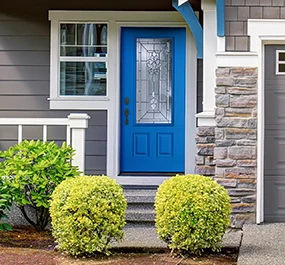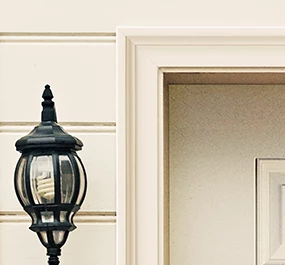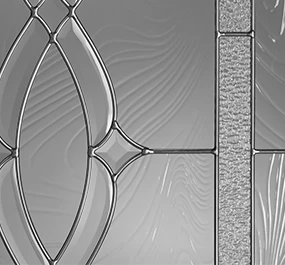Material, color, and style are often what first come to mind when choosing doors for a home or building. But one of the first choices you’ll need to make is the size of the door. So what is the standard door size? The answer varies depending on which type of door and its application. We’ll cover the standard door sizes for exterior entry doors, as well as potential variables to consider when selecting a new door unit that would fit your home.
What is standard door size?
While years of evolution have brought the millwork industry to a general agreement on the sizes of exterior entry doors, it should be noted that our use of the term “standard door size” refers to the most common size—there is no precise standardized measurement. The size of your door will depend on a variety of factors; however, knowing what sizes are most common can be helpful in getting started. Additionally, the sizes outlined here are intended to serve as a reference point for doors in the United States and Canada. Always consult with a local professional to ensure you are selecting the proper door size for your specific situation.
Please note, we will refer to the height and width of doors in feet and inches, such as 6/8, 7/0, etc. We do not refer to the door sizes in exact inches, because openings for doors are not precisely standardized into inches. Within the listed sizes we give, there is room for some slight variation in the inch measurement of the door opening that will accommodate these door sizes.
Therefore, when selecting a new door, the first thing you should determine is if you are installing a brand new, pre-hung door unit (complete with the full door hinges and frame) or if you are just replacing the existing door slab. If you are installing a brand new unit, slight variations in slab measurement are allowed and can be accommodated during unit installation. However, if you are only replacing the door slab, the slab measurements need to be exactly the same as your previous slab to avoid any potential leakage or damage.
Again, this is why we always recommend consulting and confirming with a local professional before ordering a door.
Standard door sizes for entry doors
Entry doors are often used in various applications, such as a front door, back door, door between the garage and house, hinged patio doors, etc. This creates a variety of standard door sizes. While the most common width is 3/0, there are also a variety of sizes that are commonly used.
For entry doors, the standard door sizes are:
- Width: 2/0, 2/4, 2/6, 2/8, 2/10, 3/0, 3/6
- Height: 6/8, 7/0, 8/0
- Thickness: 1 ¾ inches
A 3/0 width door is commonly used in a single slab entry application. In recent years, there has been a shift toward a 3/6 width, as the wider entryway makes it easier when moving furniture and other large items in and out of the home.
In addition to expanding the door size, many people choose a double-door configuration to create a larger entry. Double doors also add grandeur, a welcoming aesthetic, and even increase the value of the home. Double exterior entry doors are commonly built with smaller size slabs. For example, using two 2/6 width doors to build a 5/0 entry width. However other common double door widths include 2/8, 2/10 and 3/0, depending on the homeowner’s needs.
Most manufacturers will offer several size and width configurations. For example, standard Plastpro widths include 2/0, 2/4, 2/6, 2/8, 2/10, 3/0, and 3/6 and available heights are 6/8, 7/0, and 8/0. Additionally, when it comes to renovations and non-standard sizing, you may also opt for a custom size door—such as those in Plastpro’s Trimmable Door Series—to ensure the proper fit.
Prefit Size
When considering standard door sizes, keep in mind that wood doors typically come labeled as a larger size than their fiberglass or steel equivalent, because the edges will need to be beveled before installation. The standard size for wood doors is usually considered to be 36,” but that is before the door is beveled on the edges to fit for installation-the actual fitted size will be slightly smaller than 36”. Fiberglass and steel doors are labeled with a prefit size that will stay consistent, as the edges will not need to be beveled. As a reference point, you can find Plastpro’s prefit door specifications in the diagram below. Note that each manufacturer might have slight variation in the prefit sizes they offer—this diagram is only applicable to Plastpro doors.
What to consider when choosing a door size
When choosing a door size, it’s important to consider the size of your existing opening. A prehung door unit that is slightly too small can be accommodated during installation, where a too large unit cannot. The next thing to consider is the entry size and the configuration of the door unit. An opening can be configured differently depending on your need. For example, a 5/0 unit can be built with two 2/6 door slabs to create a grand entryway, or it can be configured with a 3/0 door and two 1/0 sidelites, creating a smaller entryway with the charm and natural light of sidelites. As always, it’s best to consult with a professional to ensure your door will fit properly and satisfy your needs.
And while all doors are held to the same size regulations where applicable, not all are created equal. Specifically when choosing an entry door, consider which size and shape will fit best with the exterior appeal and architectural style of your house, which material is best-suited to your home’s security and weather durability needs, and which door is the best financial investment.
Check out Plastpro’s Where to Buy page to find the closest distributor for fiberglass doors, and visit our website for a better look at fiberglass door sizing options.



